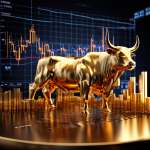Financial Disaster Recovery: Adapt or Die
April 8, 2025
The Dopamine Trap: When Euphoria Becomes the Enemy
It’s so simple, yet over the years, patience has become a relic. Common sense has evaporated, replaced by compulsive behavior disguised as conviction. The markets used to be about discipline, about resilience. Now it’s about noise—louder wins, louder trades, louder egos.
Boasting has replaced thinking. Bragging rights over gains have taken precedence over understanding risk. The ancient truth of “easy come, easy go” is brushed aside. Why? Because when euphoria takes the wheel, dopamine floods the brain. It rewires perception. Reality doesn’t vanish—it gets edited. The mind becomes a narrative machine, churning out stories to fit whatever fantasy justifies the next impulsive move.
And in that fantasy, the trader becomes the genius. The anomaly spotter. The rule-breaker destined to rewrite history. Generations of market wisdom? Irrelevant. Trends? Outdated. The market, in this fever dream, is finally listening to the One. But then reality hits. The mirage dissolves. Groundhog Day begins again. The same vow is made: “Never again.” But without understanding why the mistake was made, the cycle repeats. You don’t break patterns with promises—you break them with insight.
Fear: The Great Unmasker
Remember what we said a few updates ago? We thrive on fear. And for good reason. Fear, when viewed through a cool lens, is simple. It strips away illusion. It humbles arrogance. It forces clarity. And while it leaves most scrambling, it gives the contrarian investor a roadmap.
Euphoria is messy. It’s layered with fantasy, altered perceptions, crowd mania, and often a mix of chemical indulgences. But fear? Fear is raw. Fear is primal. And most importantly—it’s grounded in reality.
Fear is fertile ground for those who understand the psychology behind market movements. It births opportunity, not disaster. But tapping into that requires more than guts. You need the cunning of Machiavelli, the balance of Confucius, and just a touch of gallows humor.
Enter the White Swan: The Unseen Path
Right now, we are in our element. The market is laced with panic, uncertainty, and irrational fear—exactly the conditions that precede generational opportunities. Barring a true black swan—something wholly unpredictable and destructive—this chaos is setting the stage for a massive inflection point.
Forget black swans. They’re rare and by nature uncontrollable. What’s more useful are the white to beige swans—predictable patterns wrapped in emotion and amplified by crowd psychology. Historically, extreme fear always—always—morphs into outsized opportunity. It’s just that most people are too busy screaming to see it.
Bear markets give birth to baby bulls. Some crawl, some stampede. The faster they grow, the more violent their eventual correction. But the slow ones? They’re methodical, brutal, and rewarding. And right now, we are somewhere between the birth and the first breath.
This Is Not a Crash
Let’s be clear: this is not a crash. Not even close. Crashes don’t whisper—they scream. You don’t ask if it’s a crash; you know. Think COVID. Think Lehman. Think events that force the world to hold its breath. But also know this: the next real crash won’t resolve as neatly as COVID. It will be drawn out. Less dramatic in appearance, but far more corrosive.
The current market isn’t collapsing—it’s convulsing. It’s lashing out, shedding weak hands and feeding on emotion. That’s not destruction. That’s transformation. You can either get crushed trying to fight the process or position yourself for the upside that follows.
The play now is simple: don’t flinch. Watch. Wait. Act with intent. The storm that rewrites the game—that’s still out there, waiting. But this? This is the prelude.
Chaos Theory in Motion
What we’re seeing now is not noise—it’s a signal. The market, like a complex system, obeys rules that only appear chaotic on the surface. Underneath the volatility lies a fractal rhythm. Fear leads to selling. Selling leads to capitulation. Capitulation leads to irrational pricing. And irrational pricing births opportunity.
It’s the same pattern in different clothes. And each time, it feels unique. It has to feel unique, or the crowd wouldn’t buy into the delusion. But that’s the gift of chaos: within it lies the blueprint for order—if you know where to look.
This is why technical patterns, psychological setups, and market cycles matter. Not because they guarantee outcomes but because they let you see while others panic. The charts are not tea leaves. They’re emotional maps. They show you when greed is becoming desperation, and when fear is hitting the red zone.
The Anatomy of Mayhem
Watch how sentiment is shifting now. Retail is twitchy. Institutions are defensive. Volume spikes for all the wrong reasons. That’s not confidence unwinding—it’s panic blooming. And when fear blooms, prices fall far past where they should. That’s the sweet spot. That’s where you plant seeds.
Ignore the headlines. They’re written by people who missed the last turn and will miss the next. Pay attention to the reactions, not the reasons. The crowd is the indicator. When the herd screams “get out,” that’s your cue to start getting in.
It won’t feel right. It’s not supposed to. Opportunity rarely does. That’s the cost of being early—you look insane right up until you look brilliant.
The Cycle Will Break—Then Begin Again
And when the baby bull finally takes off, it might move faster than anyone expects. Or it might crawl so slowly that people forget it’s even moving. Both are dangerous in their own way. The fast bull brings euphoria, and with it, another round of delusion. The slow bull breeds doubt until doubt turns into regret.
But here’s the part most miss: the next crash is inevitable. It’s part of the design. The market expands, overextends, then corrects. Rinse; repeat. The crash is always coming. Just not now.
So the question isn’t if pain will return—it’s when and how. And your job isn’t to predict the exact moment. It’s to be positioned before the shift.
Final Thought: Don’t Worship the Cycle, Understand It
This moment—right here—isn’t the apocalypse. It’s the test. The test of your conviction, your patience, and your ability to think when everyone else is reacting. If you’ve done your homework, this is where it pays off. If you haven’t, this is your shot to start.
But don’t fall into the cycle of denial. Don’t promise you won’t repeat the past while refusing to understand it. Real change doesn’t come from vows—it comes from awareness.
Fear is speaking. Are you listening?
The Thought Catalyst













